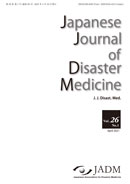Volume 26, Issue 2
Displaying 1-6 of 6 articles from this issue
- |<
- <
- 1
- >
- >|
Research article
-
2021 Volume 26 Issue 2 Pages 43-49
Published: December 24, 2021
Released on J-STAGE: December 28, 2021
Download PDF (752K)
Research report
-
2021 Volume 26 Issue 2 Pages 50-54
Published: December 24, 2021
Released on J-STAGE: December 28, 2021
Download PDF (358K)
Case report
-
2021 Volume 26 Issue 2 Pages 55-61
Published: December 24, 2021
Released on J-STAGE: December 28, 2021
Download PDF (569K)
Experience report
-
2021 Volume 26 Issue 2 Pages 62-68
Published: December 24, 2021
Released on J-STAGE: December 28, 2021
Download PDF (11801K) -
2021 Volume 26 Issue 2 Pages 69-74
Published: December 24, 2021
Released on J-STAGE: December 28, 2021
Download PDF (426K)
Preliminary report
-
2021 Volume 26 Issue 2 Pages 75-77
Published: December 24, 2021
Released on J-STAGE: December 28, 2021
Download PDF (1725K)
- |<
- <
- 1
- >
- >|
